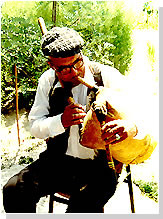 Bagpipipes
Bagpipipes
INSTRUMENTS
BAGPIPIPES
The origin of the bagpipe can be traced back to the ancient civilizations in Mesopotamia. A sculpture of bagpipes can be seen on a Hittite slab in Anatolia, dated to 1000 BCE. Wind instruments utilizing the bag, which is similar to the ancestor of the Scottish bagpipe (Gaida), had been brought to Europe by the Romans from Mesopotamia through Anatolia and Thrace. Various types of bagpipes have been played for centuries throughout in the Middle East, Caucasus, Anatolia, Europe, and North Africa. In the Northeast Anatolia, the instrument is called as tulum.
a) Tulum
b) Gayda
a) Tulum
Meaning simply "bag," the tulum is encountered chiefly in the Eastern Black Sea, around the cities of Rize, Artvin, Bayburt and Gümüshane. The tulum is sometimes known as "zurna" as well. Its bag is an animal skin turned inside-out. To one of the legs, the çifte, the five-holed double pipe is attached; to the other a wooden pipe with a leather valve is tied. This is known as the lülük. There are five holes on each of the two pipes, tuned in unison, but they are not played completely in unison; one side may hold a drone for the other.
b) Gayda
This bagpipe is played in Thrace. Instead of a pair of reeds, it has a single chanter made of hard wood. The gayda also has a single long drone pipe.

